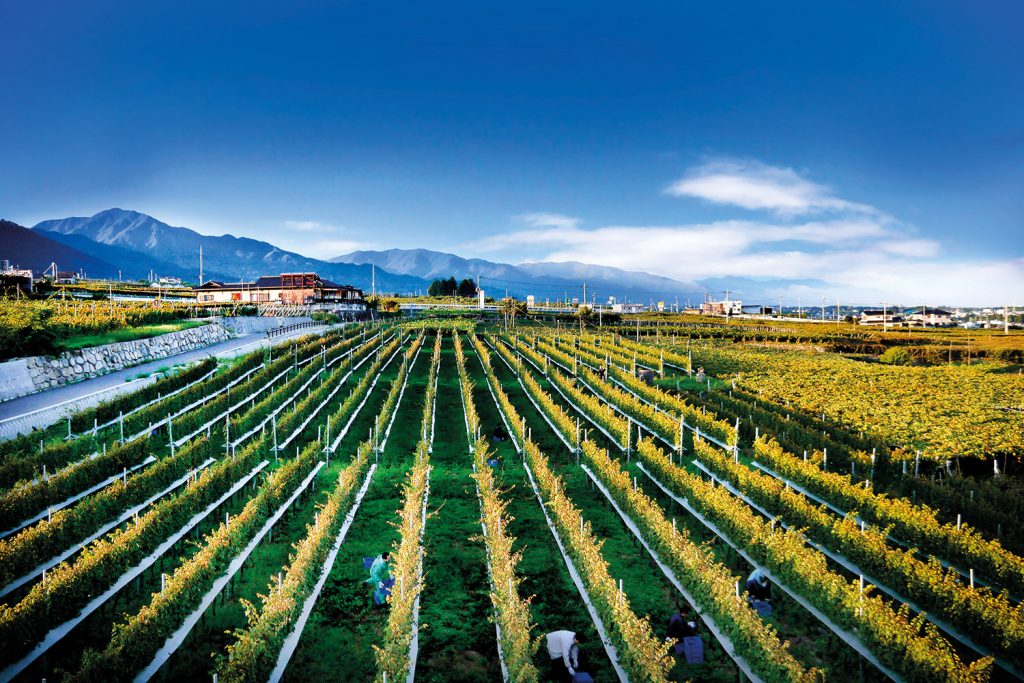A thirst for European wine in the mid-19th century saw the establishment of Japan’s own wine industry. It continues to grow.
A blanket of snow carpets the vineyard. Dark, leafless vines climb high into the trellises, spreading their gnarled arms out along the wires. The sloping hillside is carefully terraced, each small patch of level earth held firm by a small wall of intricately herringboned stone. At the foot of the vineyard runs a small stream, itself vigilantly contained in a meandering, hand-laid stone channel. The surrounding hills are covered with bare, carefully manicured peach trees. On the horizon looms the unmistakable volcanic cone of Mount Fuji, its peak covered with a layer of snow. The sky is duck egg blue. It looks just like a Hokusai landscape.
Across the stream is Katsunuma Winery. It lies in Kōshū in the heart of Yamanashi prefecture in the centre of Japan, housed in a 130-year-old merchant’s house on the banks of the waterway. On the bare wooden floors were once stacked boxes of goods but they have given way to barrels made of French oak. The winery was founded in the 1930s and focuses on producing quality wine from the local Kōshū grape variety. Jun Aruga, son of the owner Yuji Aruga, explains the long history of the pink-skinned Kōshū grape.
The grapes were first grown in the Daizenji Temple in Katsunuma for medicinal purposes. Over the next millennium, kōshū grapes were cultivated across Japan as medicine. Then, during the Meiji Restoration of the late 1800s, there was a focus on Western-style industrialisation. Steel manufacture, shipbuilding, textiles and munitions led to Japan’s rise as a military power. The adoption of European and American mores saw the dress code for men change, the planting of parks in the English style and the adoption of beer brewing and whisky distillation. Attention was turned to the vineyards and in the 1860s the government promoted winemaking.
At Katsunuma they are very proud of the way they use the now native Kōshū grape to make quality table wine. The Kōshū grape was always an eating grape but through careful selection and viticulture the winemaking team at Katsunuma have been able to produce a wine that works perfectly with Japanese food. Standing in the compact cellar door overlooking the snow and the vines, Jun pours a glass of his family’s Kōshū wine. It is pale straw. It is delicate and has a lean spine of acidity. There are very soft aromas of fruit, there is also a definite and building sensation of umami. ‘These are not wines to drink with BBQ steak,’ says Jun with a polite laugh. Instead they work perfectly with the mix of earthy, bitter, salty and umami that are found on the Japanese seasonal tasting plate or zensai.
A few kilometres away in Fuefuki stands a small Shinto shrine. In the vineyard next to it sprawls Lumiere Winery. While Katsunuma is tucked into an old warehouse by a brook, Lumiere has a footprint common to most medium-sized Australian wineries. Signposts in the vineyard mark out the varieties: tempranillo, cabernet sauvignon, merlot. The winery was founded in 1885 by local lord Tokugi Furiya after whom the winery was named until it took on its French sounding name in 1992. The cellar door is well set out for tasting with tours in English at 10.30am and 3pm. The wines are well made and show a lot of European influence. The 2013 merlot/cabernet sauvignon blend was fermented in steel tanks using naturally occurring yeasts and aged in French oak. It is an easy-drinking wine with notes of fresh brioche and chocolate on the nose intermingling with the aromas of berries. But there is something in the texture and its underlying savouriness that makes it, well, Japanese. On-site a European-style fine dining restaurant overlooks the vines and the surrounding countryside and villages. Perhaps the reds – with all that savouriness – would be better matched with soy-braised vegetables or even beef aged in saké lees instead of apricot chicken. The staff in the cellar door know how to pack bottles for visitors heading back home on a plane (very well-boxed!), so separate out one or two, to try at your local izakaya (pub) before you fly.
Further north west, near Nagano, is the wonderfully Francophile St Cousair Winery. Set on a hilltop in a clearing in a forest, St Cousair looks like a small French chateau. Throughout the year the air is filled with the aroma of fruit and spices wafting from the kitchens where they make a large range of Japanese and European preserves. The tasting room offers their apple cider and red wine blends but do try the chardonnay, in which St Cousair particularly excels. Made from local chardonnay grapes this is Japan’s answer to white Burgundy – lots of lees character, lifted fruit aroma and wonderful round texture. The attached dining room is again decorated in the French style and offers light lunches such as grilled saucisson and charcuterie.
As we depart, clouds gather around the mountain tops and another fall of snow threatens. The chilled air snaps about our faces and we shudder against the cold. A cry comes from the cloisters of the winery: ‘Spiced wine?’ A young man stirring a cauldron over a fire pours us glasses of the warming wine with a broad smile as the small flakes of snow swirl around in the wind.
Richard Cornish was guest of Hokuriku-Shin’etsu District Transport Bureau, Yamanashi & Nagano prefectures
There are 230 wineries in Japan and 90 in the Yamanashi Prefecture. Here are some of our favourites:
Katsunuma Winery – katsunuma-winery.com
Lumiere Winery – lumiere.jp/en/
St Cousair Winery (Nagano Prefecture) – stcousair.co.jp
Chateau Mars Hosaka Winery – hombo.co.jp
Note: The winery’s new address is not listed on its website:
Hosaka Nature Park 8-1, Kami-imai Hosaka Town,
Nirasaki City, Yamanashi, Japan.



Comments are closed.